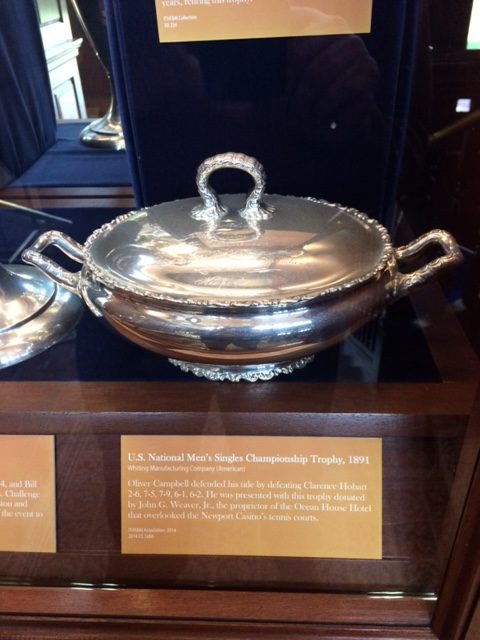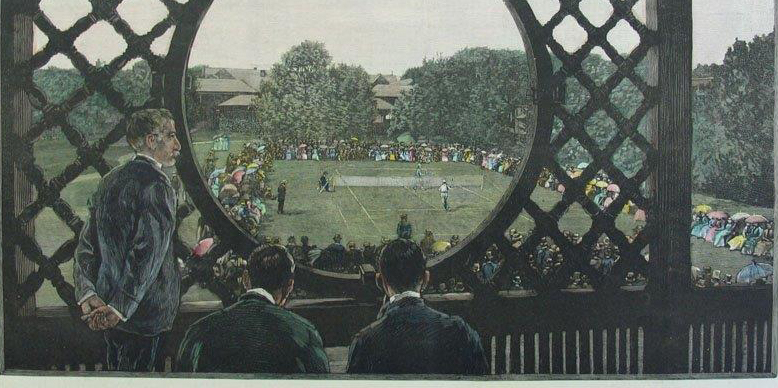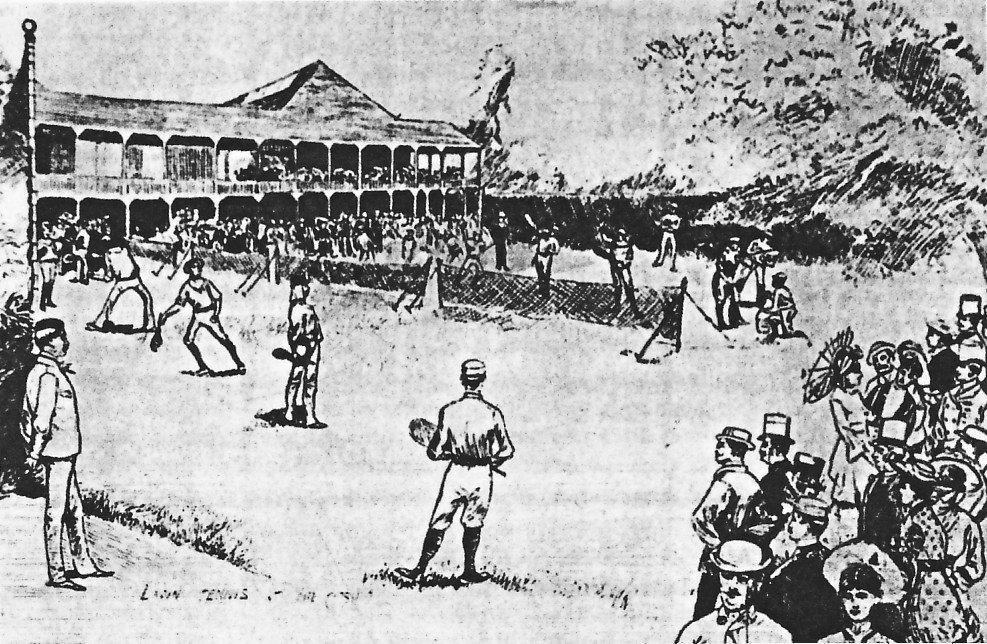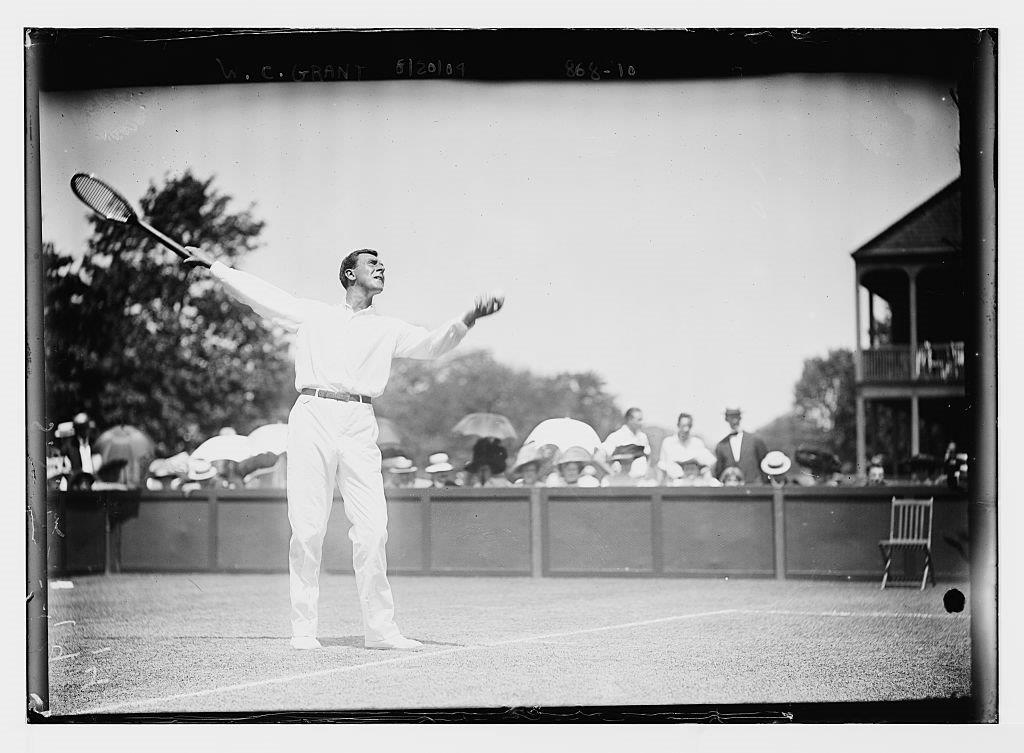The Casino, Newport, Rhode Island, is the site of the first United States Lawn Tennis Association Singles Championship, which occurred in 1881. For thirty-one years, until 1914, the tournament continued there, to be replaced by the Newport Casino Men’s Singles Invitation Tournament. The Casino now houses the National Lawn Tennis Hall of Fame and Tennis Museum that currently sponsors an annual professional tournament. Allison Danzig, a senior sports editor of The New York Times, who specialized in writing about tennis in the first part of the twentieth century, called the Casino “the true cradle of American tennis.”
Racquet games are ancient and royal. Charles d’Orleans, Chaucer, and Shakespeare describe them. But it was Major Walter Clopton Wingfield who was clever enough to patent one, combining the features of court tennis and the pastime of badminton. Although he labeled it Sphairistike, the game flourished. In 1877 the first All-England matches were held at Wimbledon.
By 1881 the game was the rage at stylish American resorts. Dr. James Dwight of Nahant, Massachusetts, and Emilius H. Outerbridge of Staten Island announced the first lawn tennis convention in the American Cricketeer. Nineteen clubs attended the New York meeting. Scoring and equipment were standardized, ending the controversies that had limited inter-club competition. A national championship tournament was called. Its date: August 31, 1881. Its site: the year-old grass courts at the Casino, Newport, Rhode Island.
Maud Howe Elliott, the daughter of Julia Ward Howe and long-time Newport resident and painter, recalled in her autobiography that lawn tennis was played in Newport in the 1870s on the estate of Mrs. Paran Stevens (later that of William F. Whitehouse). She described a match officiated by William Watts Sherman, who referred to a rulebook compiled by the Marylebone Cricket Club of England.
It was Mrs. Stevens’s neighbor, James Gordon Bennett, who built the Newport Casino in 1880 as a rebuff to his own club, the Reading Room. Bennett, whose father founded the New York Herald, was a flamboyant figure, a sportsman who established international trophies in yachting, automobile and airplane racing, and a businessman capable of breaking Gould’s transatlantic cable monopoly. He determined to build a sporting rendezvous without parallel.
Stanford White was commissioned to design the building. Bennett bought property on Bellevue Avenue across from his own estate and next to the thriving commercial property, the Travers Block. The contract with the Newport builder was for $31,300.
White, the junior partner of McKim, Mead and White, was recently returned from a prolonged European trip. Sketches and recollections from his travels, particularly of the Loire Valley, led to the Casino design. Vincent Scully and Antoinette Downing in The Architectural Heritage of Newport County called it “White’s first masterpiece in Newport.” It established the prominent Victorian idiom, the Shingle Style. Aline Saarinen, in a Life photo-essay on White’s career wrote, “White saw architecture as an expressive symbol and pictorial effect, as a permanent set of an age. A stage set was exactly what the floundering, formless new Society wanted.”
And a stage set they got. The Bellevue Avenue facade, although unobtrusive, is given vitality by the varied shingled surfaces, the projecting gables, and deeply shadowed loggia. A flat-arched passageway, elegantly paneled in a variety of carved schemes and an intricate brick pattern, leads to the inner precincts. Here, away from public gaze, the Casino members convened.
Within, two-storied arcaded wings gently curve to meet in the horseshoe piazza. Delicate Japanese latticework and Queen Anne balusters and tracery, surmounted by mellow grayed shingles, establish a gay and graceful summer setting. The stout clock tower next to the entry evokes the Loire châteaux soon to be imitated in White’s Newport “cottages.” Wide promenades lead beyond the piazza to the theater-ballroom and the court tennis building. The gallery and porch that joins these were the viewing stands for the first National Championships.

Trophy handed to Oliver Campbell as the U.S. National Men’s Singles Champion for 1891 (Tennis Hall of Fame)
Bennett’s sporting rendezvous was the center of fashionable Newport, “the daily resort of a gay and brilliant assembly of pleasure-seekers.” The Bellevue Avenue shops, and above them, the Casino club rooms, bachelors’ rooms, and the ornate billiard room were always engaged. Messrs. C. G. Muenchinger & Sons managed the restaurant and J. M. Lander was hired from New York with his 16-piece orchestra. Mrs. Louis Bruguiere, whose son, James Van Alen later became the president of the Tennis Hall of Fame, recalled the assemblies in the ballroom which White himself embellished in gold and white.
The Casino, then, was the ideal site for the first United States National tennis championship. Henry W. Slocum, champion in 1888 and 1889 could claim, in the 1931 book, Fifty Years of Lawn Tennis, “No better place could have been selected. . . . The grounds were picturesque and the courts well kept. The accommodations for the players were good, and Newport being then, as now, a fashionable resort, the most beautiful women of the country graced the tournament with their presence.”
The first United States National tennis championship in 1881 drew twenty-five players. Richard D. Sears, Harvard class of 1883, won in straight sets, and held the title through 1887. With the same consistency, he won the doubles title six times, five of them with James Dwight, the Massachusetts gentleman who called the inaugural New York conference. (Dr. Dwight officiated at Newport matches for years, and is called “The Father of American Tennis.”) Sears’s streak of seven championships has never been matched, although the great Bill Tilden held the title as often (1920-25 and 1929). Sears is credited for introducing the Lawford stroke (named for an English player for whom Sears later had to demonstrate the stroke), and the “both-up” system of doubles play.
Spectators during Sears’s reign were confined to two or three rows of chairs set around the court by Thomas Pettitt and his staff (Pettitt presided until 1948). Late-comers stood, their parasols hopelessly obscuring the view for others. The courts were hand-rolled and only vaguely marked. Trees and bushes were often within the players’ range. John Mullaly’s string band played favorite airs on the horseshoe piazza as the players hit away.
In the 1880s most of the “All-Comers” came from Rhode Island. Messrs. Nightingale and Gammell played in 1881; Metcalfe, Weeden and Hoppin appeared soon after. Mark A. DeWolfe Howe, a Lehigh tennis star, came down from Bristol to play in 1885. Robert Livingston Beeckman, who later became governor, was runner-up in 1886.

Ball boys for the 1892 tennis season and championship at the Casino were local residents (Tennis Hall of Fame)
In the 1890’s a newer crowd of college players, led by men of Harvard, appeared. A tennis circuit had developed around Boston, Philadelphia and New York clubs. Occasionally, players from England and Ireland challenged in Newport; the 1903 winner was an Irishman, H. L. Doherty. As the draw broadened, so did public interest.
The Casino governors voted to charge admission. In 1892 they bought a grandstand from the Barnum and Bailey Circus. Fred H. Hovey Brown, the 1895 Champion, recalled “ambassadors, titled visitors from abroad, operatic stars, all the headliners were there. When tennis palled, the who’s who game filled the gap.”
No Newport sports story is complete without Eleonora Sears of Boston. An avid player and devoted fan, she became Women’s Champion in 1907 (the United States Women’s National’s Singles Championship was held in Philadelphia at the Philadelphia Cricket Club, starting in 1887). The season before, when William Clothier took the men’s title, her enthusiasm for his victory and affection for the Clothiers propelled her onto the court, where she embraced the victor’s wife so heartily that they both fell to the ground. Miss Sears was runner-up in 1908 and 1912, but she took the Doubles Championship in 1911 with Hazel Hotchkiss and in 1916 and 1917 with the Norwegian player, Molla Bjurstedt.
Maude Barger-Wallach was another sportswoman who excelled at the sport and was a familiar figure at Newport tournaments for many years. She was the 1908 Women’s Champion and runner-up to Hazel Hotchkiss in 1909. Joe Leandra, the Casino professional since 1942, remembered her as “a wisp of a thing . . . with a game that would steal all your power.” Her Chinese-red wicker chair is preserved in the Hall of Fame.
The college players of the nineties took the game from the Casino summer crowd. California gave it to the nation in the next decade. The “Big Game” transformed the sport, giving it the speed and power we know today. May Sutton, Hazel Hotchkiss, and Maurice McLoughlin came East, and the game was never the same again.
Miss Sutton and her three sisters startled the galleries at Monterey with their aggressive and deliberate, if unlady-like, styles. Soon, everyone was convinced, “it takes a Sutton to beat a Sutton.” But the Nationals were in the East, and Miss Sutton had to prove herself there. She did in 1904 taking the Women’s Championship. In 1905 she sailed for England where she became the first American to win at Wimbledon. She repeated this triumph in 1907.
Hazel Hotchkiss of San Francisco recalled her first visit to the Casino in 1911. “I saw all the men players I had read about . . . and so many attractively dressed women. . . . The band also fascinated me as there had never been music connected with tennis matches anywhere else I had been.”
Maurice McLoughlin, the red-haired “California Comet” galvanized Eastern galleries with his big game based solely on the power of the serve and volley. Bill Tilden wrote that McLoughlin “changed the game from a class game to one of national importance.” Bill Talbert added, “his career was brief, but its impact is still felt in the powerful style of tennis that is played today.”
McLoughlin disparaged the Newport gallery with its distracting chatter, and silenced the crowd with his “good old five-set California battles.” He battled his way to the finals, where he lost to William Clothier.
Under the Challenge Round system, the former champion sat on the sidelines awaiting the winner for the ultimate match. In 1907, William A. Larned, the 1901 and 1902 winner, took Clothier’s title. For four seasons, Lamed observed the Nationals, emerging fresh for the finals. The controversial Challenge Round system was ended in 1911. The next year, McLoughlin won the title and he successfully defended it the next year against R. Norris Williams, II, in four sets.
McLoughlin lost his title to Williams in 1914 by scores of 6-3, 8-6, and 10-8. The match is remembered as one of the most exciting of any Newport National. Williams’s game featured sharply angled volleys, and he played close to the lines. McLoughlin’s cannonball serves and net rushes, which had been so dramatic in 1912, were now basic to the game and Williams mastered both attacks. It was appropriate that the 1914 U.S. National Championship should be so great, for it was the Casino’s last.

The crowd at the final of the U.S. National Championship at the Casino, August 27, 1913 (Library of Congress)
Aquidneck Island and Stanford White’s graceful pavilion—the very elements that made Newport the beautiful pre-war setting—gave the Nationals to Forest Hills in New York City. Richmond Barrett (1895-1968), a Newport resident recalled his despair and those of other tennis fans as they watched the Saunderstown Ferry pull away from the dock leaving them stranded after a pre-dawn start from New York. Mrs. G. Brenton Smith of Providence, a crack Little Compton player, recalled the tedious trips to Newport by motor and train through Tiverton. When there, and hungry, “we all crowded into the one place for lunch at Mary Elizabeth’s.” Newport also offered precious few beds for the evening, particularly if the overcrowded ferries once more left a fan stranded.
In 1906 the Casino governors had the Barnum and Bailey grandstand erected opposite the new Horse Show grandstand. This enlarged seating arrangement was soon over-subscribed. Boxes in the Horse Show enclosure, like those at Trinity Church, were matters of inheritance. Other seats were reserved weeks before the August tournaments. American Lawn Tennis located the 1913 crowd for the McLoughlin-Williams finals as follows: 2,500 in the east-west stands, 500 along the southern barrier, 100 in the aisles and entrances, 100 in the entrance lobby, and 700 perched on the roofs of the music pavilion, and the court tennis building, and in trees and in a few umpires’ chairs.
Mr. Barrett eluded the crowds by “hiring a pruning ladder from a ball boy. It was a rickety old giant, that ladder, about the height of a giraffe. During the second set . . , it suddenly buckled, folded up its four tired legs, tipped over backwards in dead fact.” Mr. Barrett added that the ball boys, known to all as shackers would also “produce (for a price) from some mysterious storehouse battered old bureaus and chiffoniers.”

With his strong serve and powerful play, Maurice McLoughlin (known as the California Comet) captured back-to-back U.S. championship titles in 1912 and 1913 at Newport’s Casino. He did more than any other player of his time to popularize the sport of tennis (Library of Congress)
But these were no conditions for the championships of a national sport. When the West Side Tennis Club of New York purchased land in Forest Hills, Queens, its governors hired Frederick Law Olmsted to design its grounds. Their new clubhouse was, specifically, “built for tennis.” American Lawn Tennis trumpeted its opening in April 1915 with “Sixty Courts for West Side Tennis Club,” and “the battle of the stadium versus the varicolored parasols” as Henry Slocum called it, was over. Queens would host the first men’s U.S. National Championship in August 1915, and continues to do so (now it is known as the U.S. Open and is for both men and women).
Maud Howe Elliott philosophized many years later that “Newport’s whole attitude toward tennis was social rather than sporting. So, in the end, we lost the National Tournaments.” Others said that tennis had gained in national importance and had outgrown the Casino, which was considered by some too inaccessible. Still May Sutton Bundy, winner of the 1904 women’s national championship, in a 1968 letter from California to the author, thought that “of all the places in the United States, I think Newport stands out as the most wonderful place to go and play tennis or anything else.”
[Banner image: “Lawn Tennis at Newport. The Tournament from the Upper Balcony of the Casino.” Harper’s Weekly, vol. XXIX, p. 584, September 5,1885. Note the ladies with their multicolored parasols on the sidelines (Christian McBurney Collection)]
Bibliography
Barrett, Richmond. Good Old Summer Days (New York, NY: Appleton Century Ltd., 1941).
Cummings, Parke. American Tennis (Boston, MA: Little, Brown, 1957).
Downing, Antoinette F. and Vincent J. Scully, Jr. The Architectural Heritage of Newport Rhode Island, 1640-1915. 2nd Ed. (New York, NY: Bramwell House, 1967).
Elliott, Maud Howe. This was My Newport (Cambridge, MA: The Mythology Co., 1944).
Letter from May Sutton Bundy to the author, September 3, 1968.
Talbert, Bill and Pete Axthelm. Tennis Observed (Barre, MA: Barre Publishers, 1967).
United States Lawn Tennis Association. Fifty Years of Lawn Tennis (New York, NY: 1931).



























